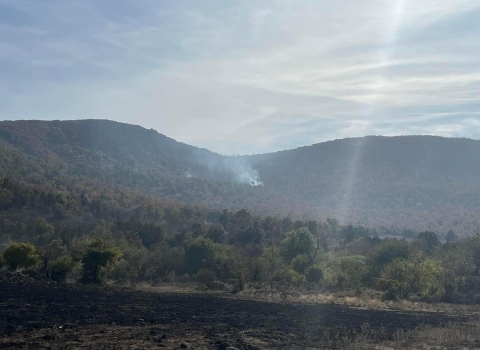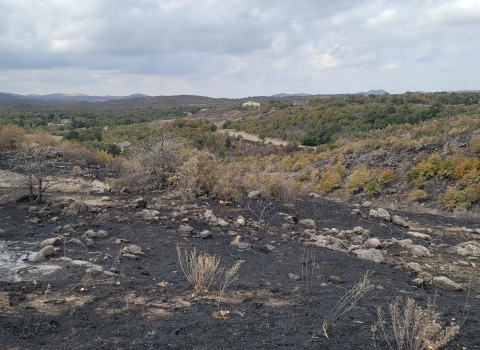The U.S. Fish and Wildlife Service (Service) announced today that a team of six researchers from Oregon State University and the University of California, Santa Cruz are the winners of a national prize challenge to combat white-nose syndrome (WNS), a lethal wildlife disease that has killed millions of bats in North America and pushed some native bat species to the brink of extinction.
The Service’s White-nose Syndrome Program launched the challenge last October as part of a multi-faceted funding strategy to develop management tools to fight the disease. A total of 47 proposed solutions were submitted for permanently eradicating, weakening or disarming Pseudogymnoascus destructans, the fungus that causes WNS, thereby improving survival in bat species affected by the disease.
A panel of 18 experts from academic institutions, federal agencies and nongovernmental organizations evaluated the challenge entries based on readiness, deployment scale, species susceptibility, ease of use, cost efficiency, efficacy and risk to resources.
The winning team – Emily Dziedzic, Jenny Urbina Gonzalez, Jared LeBoldus, Michael Gordon, A. Marm Kilpatrick and Taal Levi who hail from Oregon State University and the University of California – conceived of an aerosol spray to genetically silence the fungus that causes the disease without harming the bats, the places they hibernate, or other non-targeted organisms. The team will receive $20,000 for its proposal, which is intended to spur collaborations with scientists, designers and engineers to potentially bring the solution to life.
“White-nose syndrome is devastating native bat populations at unprecedented rates and this proposed solution from the Oregon State University and University of California team may be just the catalyst we need to give bats across North America a better chance at survival,” said U.S. Fish and Wildlife Service Director Aurelia Skipwith. “I thank all of the individuals and teams who joined the challenge, including a high school science club. It demonstrates how people of all ages and backgrounds care about wildlife and want to help conserve species and their habitats long into the future.”
“My team and I are extremely excited to be contributing to collective efforts to combat the fungus that causes white-nose syndrome in bats,” said Oregon State University graduate student Emily Dziedzic, who helped lead the winning team along with post-doctoral student Jenny Urbina Gonzales. “We greatly appreciate being recognized for our achievements on this front, and the funding will provide an essential boost to help us further our research and accomplish our goals.”
The Service also recognized Dr. Jorge Ortega from the National Polytechnic Institute of Mexico with an Honorable Mention award for his idea on a novel vaccination to immunize bats against white-nose syndrome.
"Today, more than ever, white-nose syndrome is a latent threat to our bat populations. It is our duty to protect them to maintain the good health of our ecosystems with all their interacting agents," said Dr. Ortega. "I am glad to share with you the idea of developing alternatives that allow mitigating the effects of white-nose syndrome and avoiding a decline in these important animals."
White-nose syndrome is caused by a fungus that sometimes looks like white fuzz on bats’ muzzles and wings. The fungus thrives in cold, damp places and infects bats during hibernation. White-nose syndrome has been confirmed in 35 states and 7 Canadian provinces. At some affected sites, 90 to 100 percent of bats have disappeared, most succumbing to the disease.
There is no known cure for white-nose syndrome, but scientists worldwide are working together to study the disease and how it can be controlled. Much of this work has been conducted under the umbrella of the U.S. National Response to White-nose Syndrome, a broad, multi-agency effort led by the Service.
“The national white-nose syndrome response has demonstrated we can be more innovative and impactful when we harness our collective expertise, knowledge and skills,” said Jeremy Coleman, National White-nose Syndrome Coordinator for the U.S. Fish and Wildlife Service, which leads the national response to WNS. “This challenge, and solutions like the one proposed by the team from Oregon State University and the University of California, can help create new pathways for researchers to fight the fungus and help bats to survive this devastating disease.”
Bats eat insects and are critical pest controllers. In the United States alone, bats are estimated to save farmers at least $3.7 billion per year in pest control services. Due to the drastic reduction in native bat populations, millions of insects are feeding on trees and crops, which can impact forestry, agriculture and human health.
In the coming months, the Service will announce a second challenge to offer an additional $80,000, as we continue to pursue novel, innovative solutions that could help us permanently eradicate, weaken, or disarm the fungus that causes white-nose syndrome. The Service plans to hold additional idea prize challenges in the future to invite solvers with a diverse array of knowledge, skills, expertise and perspectives to help the agency tackle today’s toughest conservation issues.
Additional information regarding the White-nose Syndrome Challenge is available at www.whitenosesyndrome.org.



